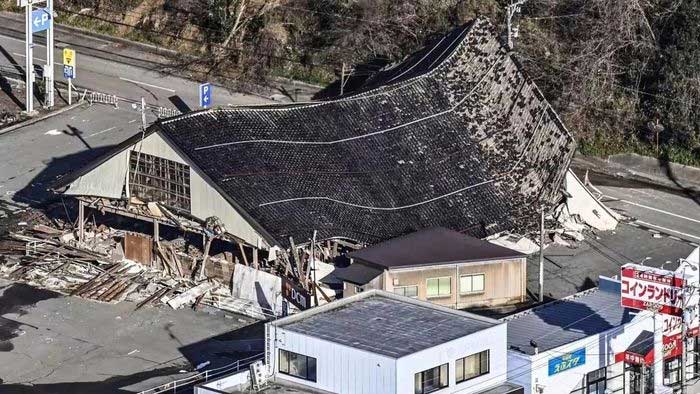It has been nearly 13 years since the horrific earthquake and tsunami that led to the nuclear disaster at the Fukushima power plant in 2011.
The fears of the Japanese people returned on the first day of 2024, when the Ishikawa region was shaken once more, and tsunami sirens echoed again. The death toll has reached nearly 50 and may continue to rise. Roads cracked and bridges were destroyed. Hundreds of buildings collapsed, leaving residents trapped beneath the debris.

Images after the earthquake in Ishikawa on January 1. (Photo: Kyodo).
Rupert Wingfield-Hayes, a former BBC Tokyo correspondent, and his wife experienced the disaster of 2011. That earthquake and tsunami left a profound collective wound on the Japanese people, from which they have learned many lessons for the future.
In the months following, the Wingfield-Hayes couple had to search for a new place to live.
“My wife studied geological maps to find the most stable ground, choosing high land far away from rivers. She was obsessed with the ages of buildings,” Wingfield-Hayes recalled, noting that his wife eliminated homes built before 1981.
After moving into a building constructed in 1985, they began stockpiling food and water. Under the sink in their bathroom were cartons of packaged food with a shelf life of five years.
Despite the extensive damage, the earthquake on January 1 also tells a remarkable story of Japan’s success in mitigating disaster impact.
In fact, the experiences Japan has accumulated over a century in dealing with earthquakes began after the Great Kanto Earthquake of 1923, which leveled cities and claimed 140,000 lives.
The severe consequences that year compelled the country to draft its first earthquake-resistant building codes. Since then, new buildings have required reinforcement with steel and concrete, while wooden structures must have thicker beams.
Each time the country endured a significant earthquake, the damages were studied, and regulations were updated.
The most significant leap occurred in 1981, when all new buildings were required to implement seismic isolation measures. Again, many lessons were learned after the Kobe earthquake in 1995.
Japan does not report earthquakes by magnitude (Richter scale); instead, it measures them by ground shaking intensity. The Japan Meteorological Agency (JMA) uses a scale called shindo (shaking intensity), ranging from 1 to 7. In the Ishikawa earthquake, the shaking reached a maximum intensity of 7.
The JMA operates 180 seismometers and 627 seismic intensity meters, reporting earthquakes in real-time to media and online.
The benchmark for Japan’s success was demonstrated when a magnitude 9.0 earthquake struck in 2011; the shaking in Tokyo reached level 5. This figure is equivalent to the shaking experienced by the capital in 1923.
However, in 2011, while massive skyscrapers shook and windows shattered, no large buildings collapsed. It was the tsunami that claimed thousands of lives, not the ground tremors.
- Japan earthquake raises ground by over 4m
- At least 57 confirmed dead, Japan efforts in rescue after earthquake
- Strange phenomena before earthquake in Japan: Unusual lights across the sky, flocks of birds create rare sight
- Cascading disasters in Japan: Earthquake causes major fires, widespread communication disruptions



















































